Contact
Swedish Centre for Nature Interpretation (SCNI)
Department of Urban and Rural Development, Swedish University of Agricultural Sciences (SLU)
scni@slu.se
www.scni.se
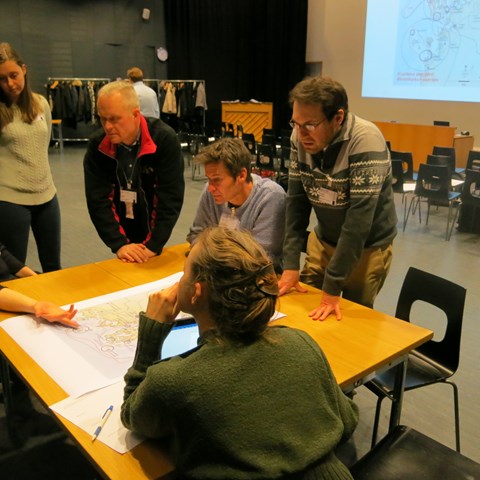
The world heritage site High Coast / Kvarken Archipelago decided to produce a heritage interpretation plan and the Swedish Centre for Nature Interpretation (SCNI) was hired to lead the process for that work. From 2018 to 2020 several activities were held including an educational day, several workshops and try-outs of planned nature and activity trails, parallel with the writing process of the plan. A lot of local actors were involved in the process. This resulted in a better basis for future decisions about nature interpretation in the World Heritage site as well as development of methods for interpretive planning for us at SCNI. Here you can read about the working process.
Far from all world heritage sites have a plan for heritage or nature interpretation. According to UNESCO there are advantages with such plans in order to secure visitors' experiences of, understanding of and possibility to form relationship to the place and its values. Therefore UNESCO has decided that new candidates for World Heritage sites must present an heritage interpretation plan already in the application. The heritage interpretation plan that has been made for High Coast / Kvarken Archipelago is an example of a plan that has been made in an existing World Heritage site. The Swedish Centre for Nature Interpretation (SCNI) contributed with support throughout the whole process - here we tell you more about what happened in the process.
The High Coast / Kvarken Archipelago is a world heritage site shared between Sweden and Finland. Here the land uplifting processes are in focus. The rising mountain tops of the High Coast with a view over the sea in the west and Kvarken Archipelago that mainly consists of moraine ridges in the east, have together been pointed out by UNESCO as the best area in the world for understanding land uplifting and how the latest inland ice sheet affected the landscape. The County Administrative Board in Västernorrland and the Finnish state-owned company Metsähallitus gave in 2018 SCNI the assignment to facilitate the process in wich the two World Heritage administrations were to produce a heritage interpretation plan for the area. This process was done within the framework of the large EU project Lystra.
The goal with the project was to welcome more visitors to the World Heritage site without jeopardizing a sustainable development, to increase the understanding of the values of the World Heritage site and to create a high class knowledge base in order to meet the needs of both nature tourism and of land use planning. With the help of the heritage interpretation plan they wanted to highlight the unique values of the world heritage site and to find a common story of the whole World Heritage site. The plan would describe how the World Heritage site should be presented on both physical and digital visitation sites. The purpose was that the visitors would get a better experience and understanding of the World Heritage site and its values.
SCNI has since 2014 participated in and/or supported several planning processes within heritage interpretation:
In the project in Bergslagen it was included to produce the method tutorial Platsens berättelser (in English The stories of the Place), which is published at the Swedish National Heritage Board. 2018 the Swedish EPA published the handbook Naturvägledning i natur- och kulturområden (in English Nature Interpretation in Natural and Cultural Heritage Areas), produced by SCNI as an assignment from and in cooperation with the Swedish EPA. The handbook is supposed to function as a support for mainly the Regional Administrative Boards in their planning of heritage interpretation. 2014-2017 SCNI participated in the research project Planning of heritage interpretation, meaning and systems thinking, that was funded by the Swedish National Heritage Board and under the direction of the Division of Environmental Communication at SLU.
SCNI's ambition in participating in the work with the heritage interpretation plan for the World Heritage site High Coast / Kvarken Archipelago, except to contribute to the direct project goals, was to continue to develop knowledge about planning of heritage interpretation. This time in a World Heritage area with relatively complex phenomena where there already was a lot of information for the visitors. An area shared by two countries, national administrations and language areas, and in a cooperation process with a great amount of local administrations and actors that are involved in communication with visitors.
In May and July 2018 CNV visited both High Coast and Kvarken Archipelago in order to get our own perception of the World Heritage site, its values and to be able to take part of already existing heritage interpretation and the different adminstrations' current planning. The visits contributed to valuable knowledge for the continued work with the heritage interpretation plan.
Se post on Facebook from the visit at High Coast here and from Kvarken Archipelago here.
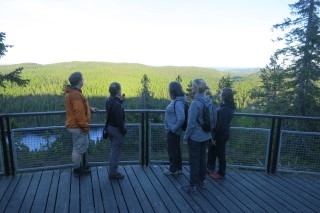
On September 18th 2018 an educational day was held in Vasa in Finland about heritage interpretation and about the method, thematic interpretation, as a support for the planning of heritage interpretation in the World Heritage site. The persons that were invited to the educational day worked with the Lystra project or in the financing organizations. Read more about the education day here.
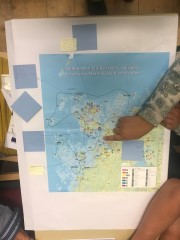
SCNI held workshops in October 2018 and in January 2019. Invitations were sent out broadly, with the purpose to reach as many relevant actors as possible. That meant that everybody involved in communication and pedagogics within the World Heritage site were invited: enterprises, associations, schools, municipalities and other organizations. In October one workshop was first held in Vasa in Finland and then one at the High Coast in Sweden. We worked together with actors around the mutual theme for the whole World Heritage site, that is the core message or read thread in the communication with the visitors. Read more here about the workshops in October.
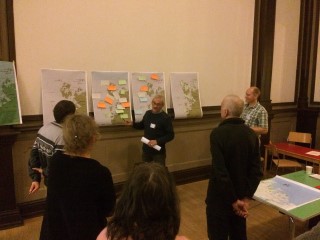
In order to facilitate for the participants at the follow-up workshops in January they were held at two different occasions (afternoon and evening) at each of the two locations. The same actors that were invited in October were also invited to the workshops in January. This time the focus was specific places within the World Heritage site and how they could be highlighted. The discussion was about how the World Heritage site in the best way would be presented at the different places so that all the identified visitor groups could be reached. Read here more about the workshops in January.
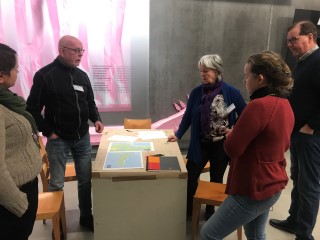
Overall reflections about the work with the workshops in October and January from us that worked with them:
Parallel with the workshops the writing process of the heritage interpretation plan was started. Read more about the writing process here.
Two trials of heritage interpretation were made on site in the World Heritage with the heritage interpretation plan as a support. The trials were performed at Hornöberget on the High Coast during summer 2019 and at Svedjehamn in Kvarken Archipelago during summer 2020. Experience/nature paths of different characteristics was planned for both these sites. Before the trials temporary version (prototypes) of, for example, direction markings, signs, models, u-turns (self powered wind up audio players), treasure chests were made. This made it possible to test the planned heritage interpretation before it was in place. People that represented the different intended target groups were invited to test, reflect over and assess the heritage interpretation. The trials were performed by the Regional Administrative Board of Västernorrland and Metsähallitus in cooperation with SCNI. Read more about the tests here.
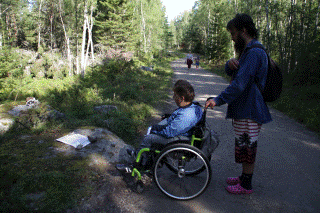
You can read the heritage interpretation plan for the World Heritage here.
Anna Carlemalm from the Regional Administrative Board of Västernorrland and Malin Henriksson from Metsähallitus think that it has been good to have external experts that guided them through the process, especially in the beginning. They feel that they themselves now have become experts and developed a deeper knowledge about heritage interpretation in the World Heritage site, and that they because of this more freely can elborate and adjust it to their needs etc.
They also think that it has been good that the process was allowed to take its time, from collecting background facts about places and visitors, via workshops to an ongoing process of writing and comments on that. It has contributed to a good end result.
For SCNI the initial educational day for the people involved in the project was valuable as a basis. It contributed to a mutual level of knowledge about heritage interpretation in the continued work.
Anna and Malin think that the workshops with the local actors were important. That way the public got involved in a good way. They also think that it was good that the workshops could be held in both countries and that several people from the administrations have been able to participate and to work with them. This contributed to that the people in the working group became closer to one another. Also SCNI thinks that the workshops resulted in wished for input about involvement, places and ideas as well as to valuable anchoring with and contact ways to the local actors.
It is significant to get a clear picture of who is visiting the World Heritage site and therefore an idea about for which groups the heritage interpretation should be aimed. This work was facilitated with newly produced visitor surveys as a starting point.
It can be a challenge to formulate and create a main theme (with the method thematic interpretation) that is interesting and relevant enough for the visitors. We at SCNI emphazise that, during the process of producing the interpretation plan a preliminary main theme should be recurrently processed. When the theme is in place it provides good support in the process.
In order to make the heritage interpretation plan a document easy to use, it should be clarified in the document how it is meant to be used, by whom and how to follow up set goals for continuous development.
It has worked well with frequent video meetings for the working group. A lesson made is to make sure that meetings are regularly booked when everybody in the working group can discuss the process and update what needs to be done.
For SCNI's overall work with method development it has been very valuabel to follow the work during the whole process, parallel with the implementation of the concrete process facilitation assignment. How the formulation of themes took place in collaboration between many actors, how the project organization used the emerging plan in its pilot trials, how visitors at the pilot trials reflected on their experiences and finally how the administrations in their turn received and used that knowledge in further planning.
The focus on cooperation with local actors in the discussion about communication and themes has as far as SCNI can assess been valuable for the process. That in combination with the implementation of the pilot trials where the heritage interpretation is being tested in practice, results in that the whole process allows for different perspectives as well as room to respond to visitors' interests and reflections.
Inspired by the development of the heritage interpretation plan, two initiatives have been made in Finland:
Both projects are mainly financed by the Finnish Ministry of Education and Culture through project funds for development of cultural tourism in World Heritages sites.
The heritage interpretation plan for the World Heritage High Coast / Kvarken Archipelago.
Swedish Centre for Nature Interpretation (SCNI)
Department of Urban and Rural Development, Swedish University of Agricultural Sciences (SLU)
scni@slu.se
www.scni.se